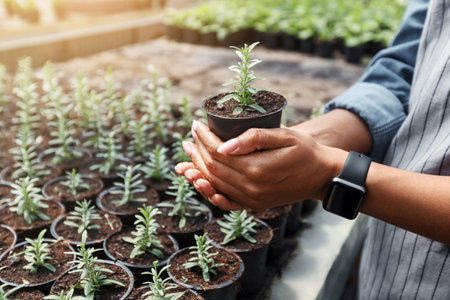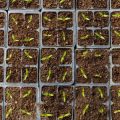1. Planning Your Zero-Waste Greenhouse
Building a zero-waste greenhouse starts with smart planning. Before you lay the first brick or install any panels, it’s important to focus on three key areas: site selection, understanding your local climate, and taking full advantage of natural resources like sunlight and rainwater. These foundational steps help set the tone for a sustainable and efficient growing space.
Site Selection
Choosing the right location is crucial. You want to place your greenhouse where it can get the most sunlight year-round while staying protected from harsh winds and flooding. In most parts of the U.S., a south-facing orientation gives you optimal sun exposure.
Key Factors for Site Selection
| Factor | Why It Matters |
|---|---|
| Sunlight Exposure | Maximizes natural light, reducing need for artificial lighting |
| Shelter from Wind | Lowers heat loss and structural stress |
| Avoiding Low-Lying Areas | Prevents flooding and improves drainage |
| Proximity to Water Source | Makes irrigation easier and more efficient |
Climate Considerations
Your local climate will influence everything from what materials to use to what crops you can grow. For example, in colder states like Minnesota or Vermont, insulation and passive heating methods are essential. In warmer areas like Arizona or Texas, ventilation and shading become top priorities.
Main Climate Zones in the U.S. and Their Needs
| Region | Main Climate Concern | Sustainable Solution |
|---|---|---|
| Northern States (e.g., Michigan) | Cold winters, short daylight hours | Add thermal mass (like water barrels) for passive heat storage; maximize south-facing windows |
| Southeast (e.g., Florida) | High humidity and heat | Add vents or solar-powered fans; use shade cloth during peak sun hours |
| Southwest (e.g., Arizona) | Drought conditions, extreme heat | Capture rainwater; install reflective roofing material to reduce heat gain |
Maximizing Natural Resources
A big part of going zero-waste means using what nature gives you—for free! That means making the most of sunlight for warmth and photosynthesis, collecting rainwater for irrigation, and using thermal mass to store heat naturally.
Sustainable Resource Strategies
- Sunlight: Use transparent glazing like polycarbonate panels to let in plenty of light while keeping in heat.
- Rainwater: Set up gutters along the roof that feed into a storage barrel system—great for watering plants without relying on city water.
- Thermal Mass: Incorporate materials like stone, brick, or water containers inside your greenhouse to absorb daytime heat and release it at night.
The planning stage is all about laying a strong foundation—literally and figuratively—for a zero-waste greenhouse. When you thoughtfully consider where youre building, what climate youre working with, and how to harness natures own tools, youre already halfway toward a truly sustainable setup.
2. Choosing Sustainable and Recycled Materials
When building a zero-waste greenhouse, one of the most important steps is selecting the right materials. Choosing sustainable or recycled options not only helps reduce your environmental impact but can also save money and give your greenhouse a unique character. Here are some eco-friendly building materials commonly available in the U.S., along with their pros and cons.
Reclaimed Wood
Reclaimed wood is salvaged from old barns, factories, or homes. Its a great choice for framing and shelving.
| Pros | Cons |
|---|---|
| Eco-friendly, reduces deforestation | May require extra prep (cleaning, sanding) |
| Unique look with natural weathering | Can be more expensive than new lumber |
| Durable when properly treated | Quality can vary depending on source |
Recycled Glass Panels
Recycled glass is often used for greenhouse glazing. It’s made from post-consumer glass and offers good light transmission.
| Pros | Cons |
|---|---|
| Great light clarity for plant growth | Heavy and may need strong framing support |
| Sustainable alternative to new glass or plastic | Can be fragile if not tempered |
| Available through many building reuse centers | Might be harder to find in large sizes |
Repurposed Metal Framing
Using repurposed metal like steel or aluminum from old structures is another smart option for your greenhouse frame.
| Pros | Cons |
|---|---|
| Extremely durable and long-lasting | May require welding or custom fitting tools |
| Often available at scrap yards or demolition sites | Heavier than wood, harder to handle alone |
| Pest-resistant and fireproof | Might need rust-proofing treatment if not stainless or galvanized |
Where to Find These Materials in the U.S.
- Habitat for Humanity ReStores: Great for reclaimed wood, windows, and sometimes metal parts.
- Local salvage yards: Ideal for finding unique materials at affordable prices.
- Craigslist, Facebook Marketplace: Many homeowners give away leftover or used building supplies.
- Lumber yards and recycling centers: Some offer discounted recycled products.
Selecting the right combination of these sustainable materials will set a strong foundation for your zero-waste greenhouse project. Keep an open mind—sometimes the best pieces are the ones you didn’t plan on using!
![]()
3. Construction Techniques That Minimize Waste
Building a zero-waste greenhouse isnt just about choosing the right materials—its also about how you put everything together. Smart construction methods can greatly reduce waste, save money, and make your greenhouse more sustainable in the long run. Here are some practical techniques to help you build with minimal material waste.
Modular Construction
Using modular design means building your greenhouse in sections or panels that fit together like puzzle pieces. This method helps reduce off-cuts and allows for easier repairs or expansions later on.
Benefits of Modular Design
| Benefit | Description |
|---|---|
| Less Material Waste | Pre-measured modules reduce cutting errors and scrap materials. |
| Easier Repairs | You can replace individual parts without tearing down the whole structure. |
| Future Flexibility | Add-on modules let you expand your greenhouse as needed. |
Precise Cutting Practices
Before cutting any materials, plan and measure carefully. Use cutting templates or software tools to lay out dimensions efficiently on your raw materials. This practice reduces offcuts and makes better use of every board, panel, or pipe.
Tips for Accurate Cutting
- Use measuring tape and square rulers for straight, accurate lines.
- Cut all similar-sized parts at once to avoid repeating measurements.
- If using wood or metal, label each piece after cutting for easy assembly.
Insulation Options That Reduce Waste
A well-insulated greenhouse keeps heat in and reduces energy use. Choosing insulation methods that produce little or no waste is key to staying zero-waste-friendly.
Low-Waste Insulation Choices
| Insulation Type | Waste Impact | Notes |
|---|---|---|
| Bubble Wrap (Reused) | Minimal if reused from packaging | Effective for small greenhouses; lightweight and easy to apply |
| Polycarbonate Panels | Low with precise sizing | Durable and offers good thermal performance; order pre-cut to size if possible |
| Natural Wool Insulation | Biodegradable and renewable | Sustainable choice but may be pricier; great for eco-conscious builds |
By combining smart planning with efficient building methods, you can significantly cut down on construction waste while creating a functional and eco-friendly greenhouse. These techniques not only support a zero-waste lifestyle but also lead to a more organized and cost-effective project.
4. Integrating Zero-Waste Systems
Creating a zero-waste greenhouse means building a self-sufficient environment where every resource is reused or recycled. By integrating systems like composting, rainwater harvesting, solar energy, and hydroponics or vertical farming, you can reduce your environmental impact while supporting healthy plant growth.
Composting: Turning Waste into Nutrients
Instead of throwing away plant trimmings, kitchen scraps, or dead leaves, turn them into compost. Composting transforms organic waste into nutrient-rich soil that helps your plants thrive naturally without chemical fertilizers.
Benefits of Composting:
- Reduces landfill waste
- Improves soil structure and fertility
- Lowers the need for synthetic fertilizers
Rainwater Harvesting: Sustainable Water Supply
Collecting and storing rainwater gives you a free and sustainable source of water for your greenhouse. This system reduces your dependence on municipal water and makes watering more environmentally friendly.
Simple Rainwater Collection Setup:
| Component | Description |
|---|---|
| Roof Catchment | Catches rain as it falls on the greenhouse roof |
| Gutters & Downspouts | Direct rainwater to collection barrels or tanks |
| Storage Container | Holds collected rainwater for future use |
| Filter System (optional) | Keeps debris out of stored water |
Solar Energy: Power from the Sun
Installing solar panels on or near your greenhouse allows you to harness clean energy for heating, lighting, and powering small devices. Solar power is especially useful for running fans, grow lights, or irrigation timers in off-grid or remote setups.
How Solar Helps in a Greenhouse:
- Powers LED grow lights during low-light seasons
- Keeps ventilation systems running efficiently
- Cuts down electricity bills and carbon footprint
Hydroponics & Vertical Farming: Efficient Growing Methods
If youre tight on space or want to grow more with fewer resources, hydroponics and vertical farming are great options. These systems use less water than traditional gardening and often produce faster growth with fewer inputs.
Comparison Table:
| System | Main Benefit | Water Usage | Space Efficiency |
|---|---|---|---|
| Hydroponics | No soil needed; faster plant growth | Uses up to 90% less water than soil gardening | Moderate — horizontal layout with stacked trays possible |
| Vertical Farming | Saves space by growing upward | Low to moderate depending on setup | High — ideal for limited floor area |
Together, these zero-waste systems work hand-in-hand to create a greenhouse thats not only productive but also eco-friendly and efficient. Start with one system and add others over time to build a truly sustainable growing environment.
5. Ongoing Maintenance and Waste Reduction
Maintaining a zero-waste greenhouse isnt just about how you build it—its also about how you take care of it over time. With the right sustainable practices, you can keep your greenhouse running efficiently while minimizing waste. Here are some simple and eco-friendly tips to help you do just that.
Natural Pest Control
Avoid using chemical pesticides by opting for natural pest control methods. These not only protect your plants but also support the overall health of your greenhouse environment. Here are a few popular options:
| Method | Description |
|---|---|
| Beneficial Insects | Introduce ladybugs or praying mantises to eat harmful pests like aphids and mites. |
| Neem Oil Spray | A plant-based oil that repels pests without harming beneficial insects. |
| Companion Planting | Grow plants like marigolds or basil near vegetables to naturally deter pests. |
Closed-Loop Fertilization
A closed-loop fertilization system reuses nutrients from within the greenhouse instead of relying on external synthetic fertilizers. This reduces waste and helps maintain healthy soil. Heres how you can implement this method:
- Compost Your Scraps: Use plant trimmings, fallen leaves, and other organic material to create nutrient-rich compost.
- Worm Bins: Red wigglers break down food scraps into worm castings, an excellent natural fertilizer.
- Liquid Fertilizer from Compost Tea: Soak compost in water to extract nutrients and use it as a liquid feed for your plants.
Upcycling Used Greenhouse Materials
Instead of throwing away old greenhouse supplies, look for ways to give them a second life. This reduces landfill waste and saves money. Here are some ideas:
| Material | Upcycling Idea |
|---|---|
| Plastic Containers | Use as seed starters or small pots for seedlings. |
| PVC Pipes | Create trellises or irrigation systems for climbing plants. |
| Old Wood Pallets | Build shelving units or raised garden beds inside the greenhouse. |
Regular Maintenance Tips
Sustainable upkeep involves more than cleaning—it’s about observing and responding to changes in your greenhouse ecosystem. Follow these tips regularly:
- Inspect for Leaks or Drafts: Seal gaps to maintain consistent temperatures and reduce energy loss.
- Monitor Soil Health: Rotate crops and add compost to keep soil fertile and balanced.
- Curtain Off Unused Areas: Save energy by isolating zones that aren’t currently in use.
- Clean Reusable Tools & Trays: Sanitize with vinegar or mild soap to avoid introducing diseases while avoiding harsh chemicals.
The key to successful zero-waste maintenance is staying proactive and creative with resources you already have. With these eco-conscious habits, your greenhouse will not only thrive but do so in harmony with nature.


